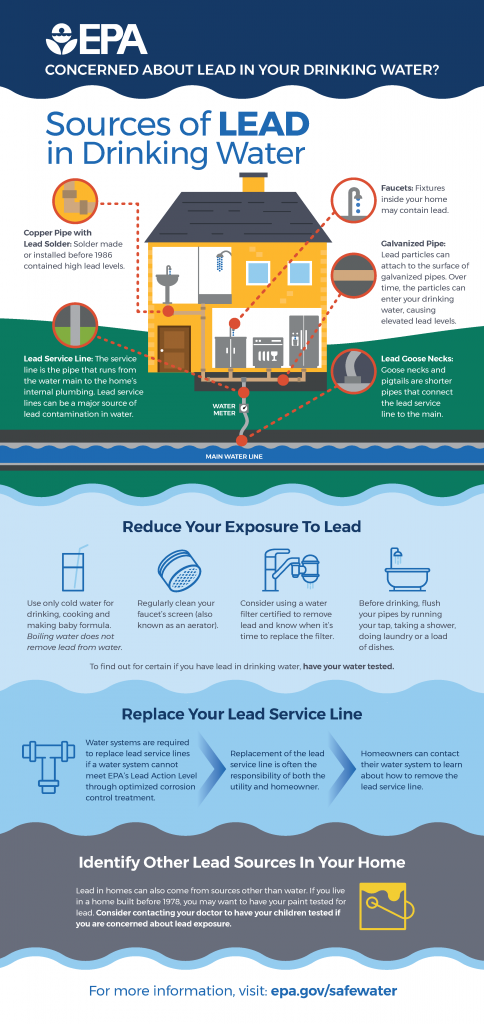Click here to read a letter concerning lead in applesauce pouches.
Lead Exposure
Lead can enter a person’s blood through drinking water, but it is not the only – or the primary source – of lead exposure. National studies show that exposure to lead in drinking water makes up only 10–20% of elevated blood lead levels (EBLLs), and 80% or more comes from:
- exposure to lead-based paint (the majority of the exposures)
- lead dust brought home from work (construction, manufacturing, steel fabricating, etc.)
- imported items like spices, ceramic pots, toys, cosmetics, and home remedies
How does lead get into water?
Lead can enter drinking water when plumbing materials that contain lead corrode, especially where the water has high acidity or low mineral content that corrodes pipes and fixtures. The most common sources of lead in drinking water are lead pipes, faucets and fixtures. In homes with lead pipes that connect the home to the water main, also known as lead services lines, these pipes are typically the most significant source of lead in the water. Lead pipes are more likely to be found in older cities and homes built before 1986. Among homes without lead service lines, the most common problem is with brass or chrome-plated brass faucets and plumbing with lead solder.
Learn more about the dangers of lead-based paint exposures through DPH’s Office of Lead Poisoning Prevention.
Learn more from EPATesting Source Drinking Water for the Presence of Lead Levels
Public water systems are required to sample for lead and copper in accordance with EPA regulations. Any exceedances are reported on their Consumer Confidence Reports (these can be obtained on Drinking Water Watch), which are distributed annually to consumers within public water systems’ jurisdictions.
Each drinking water system samples for lead and copper independently. The Division of Public Health monitors results and ensures compliance. Sampling schedules are based on a number of variables and sampling history.
Drinking Water Watch provides a great amount of information related to public water systems. Consumers can find lead and copper sample results and any violations.
By clicking the “Review Consumer Confidence Data,” you can view the most recent Consumer Confidence Report for municipal and utility (like Veolia, Tidewater, and Artesian). Helpful tool: just type in a keyword like “Dover” or “Wilmington” or “Artesian” to learn more. Or simply click on the County Map tab and scroll to find your water provider.
Example of available data once on the water system’s page:
- Lead and copper sample summary results
- Violations/enforcement actions
Questions? Please contact the Division of Public Health and the Department of Education





